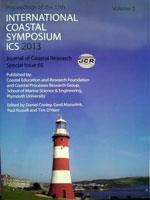Araújo Jr., W.P. and Asp, N.E., 2013. Hydrodynamic connectivity between two macrotidal Amazonian estuaries
The hydrodynamic connectivity between the Taperaçu and the Caeté estuaries at the east sector of the Amazon Coastal Zone, through the Taici channel was investigated. Water levels, currents, salinity and suspended solid concentration (SSC) were measured at both ends and at the middle of the channel. The measuring campaigns were carried out during neap and spring tides, including also the wet and dry seasons. The results have showed a strong tidal asymmetry, with ebb phases lasting approx. 40% longer than the flood. On the other hand, the flood phase is longer and takes place first and reaches higher levels at the Caeté side in comparison to the Taperaçu side, despite neap/spring or wet/dry variations. During the wet season the depth-integrated ebb current velocity reached 1.5 m.s−1 at the Taperaçu side and 1.4 m.s−1 at Caeté side, whereas during the flood it reached 0.9 and 0.8 m.s−1 at Taperaçu and Caeté sides, respectively. During dry season velocities were smaller, especially during the ebb. Maximum SSC was around 1 g.L.−1 during neap tides, whereas during the spring tide the SSC reached 2 g.L−1 at the Taperaçu and 1.5 g.L−1 at the Caeté side. Beside current direction, the salinity was meaningful for the investigation of the hydrodynamic connectivity, as the Taperaçu and Caeté waters show important salinity differences. Combining hydrodynamic data, SSC and salinity, it is possible to state that there is an effective hydrodynamic connection between the estuaries through the Taici channel. The connection is represented by the water flux from Caeté into the Taperaçu during the beginning of the flood phase, which took place first at the Caeté side in all measured situations. This is caused by the substantial infilling of the Taperaçu hindering the incoming tidal wave, as well as by the differences in estuarine position and orientation. Thus, a Caeté to Taperaçu pressure gradient is established, resulting in the observed flow. However, this flux is reduced at neap tides, especially during the dry season, due to lower water levels. When the tide also rises at the Taperaçu, that flow is interrupted. During the ebb phase there is no evidence of the opposite process. Therefore, the flux between the estuaries is effective and is the result of a complex interaction of tidal asymmetry, tide delay between the estuaries, seasonal variations of precipitation and fluvial discharge, as well as morphologic differences among the estuaries.





